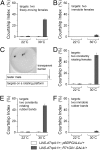Joint control of Drosophila male courtship behavior by motion cues and activation of male-specific P1 neurons
- PMID: 22645338
- PMCID: PMC3382505
- DOI: 10.1073/pnas.1207107109
Joint control of Drosophila male courtship behavior by motion cues and activation of male-specific P1 neurons
Abstract
Sexual behaviors in animals are governed by inputs from multiple external sensory modalities. However, how these inputs are integrated to jointly control animal behavior is still poorly understood. Whereas visual information alone is not sufficient to induce courtship behavior in Drosophila melanogaster males, when a subset of male-specific fruitless (fru)- and doublesex (dsx)-expressing neurons that respond to chemosensory cues (P1 neurons) were artificially activated via a temperature-sensitive cation channel (dTRPA1), males followed and extended their wing toward moving objects (even a moving piece of rubber band) intensively. When stationary, these objects were not courted. Our results indicate that motion input and activation of P1 neurons are individually necessary, and under our assay conditions, jointly sufficient to elicit early courtship behaviors, and provide insights into how courtship decisions are made via sensory integration.
Conflict of interest statement
The authors declare no conflict of interest.
Figures




References
-
- Hall JC. The mating of a fly. Science. 1994;264:1702–1714. - PubMed
-
- Greenspan RJ, Ferveur JF. Courtship in Drosophila. Annu Rev Genet. 2000;34:205–232. - PubMed
-
- Tompkins L. Genetic analysis of sex appeal in Drosophila. Behav Genet. 1984;14:411–440. - PubMed
-
- Gailey DA, Lacaillade RC, Hall JC. Chemosensory elements of courtship in normal and mutant, olfaction-deficient Drosophila melanogaster. Behav Genet. 1986;16:375–405. - PubMed
Publication types
MeSH terms
Grants and funding
LinkOut - more resources
Full Text Sources
Molecular Biology Databases

